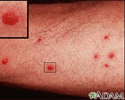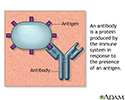Schistosomiasis
Bilharzia; Katayama fever; Swimmer's itch; Blood fluke; Snail fever
Schistosomiasis is an infection with a type of blood fluke parasite called schistosomes.
Causes
You can get a schistosoma infection through contact with contaminated water. This parasite swims freely in open bodies of fresh water.
When the parasite comes into contact with humans, it burrows into the skin and matures into another stage. Then, it travels to the lungs and liver, where it grows into the adult form of the worm.
The adult worm then travels to its preferred body part, depending on its species. These areas include the:
- Bladder
- Rectum
- Intestines
- Liver
- Veins that carry blood from the intestines to the liver
- Spleen
- Lungs
Schistosomiasis is not usually seen in the United States except for returning travelers or people from other countries who have the infection and are now living in the United States. It is common in many tropical and subtropical areas worldwide.
Symptoms
Symptoms vary with the species of worm and the phase of infection.
- Many parasites may cause fever, chills, swollen lymph nodes, and swollen liver and spleen.
- When the worm first gets into the skin, it may cause itching and a rash (swimmer's itch). In this condition, the schistosome is destroyed within the skin.
- Intestinal symptoms include abdominal pain and diarrhea (which may be bloody).
- Urinary symptoms may include frequent urination, painful urination, and blood in the urine.
Exams and Tests
Your health care provider will examine you. Tests that may be done include:
- Antibody test to check for signs of infection
- Biopsy of tissue
- Complete blood count (CBC) to check for signs of anemia
- Eosinophil count to measure the number of eosinophils, a type of white blood cell
- Kidney function tests
- Liver function tests
- Stool examination to look for parasite eggs
- Urinalysis to look for parasite eggs
Treatment
This infection is usually treated with the drug praziquantel or oxamniquine. This is usually given along with corticosteroids. If the infection is severe or involves the brain, corticosteroids may be given first.
Outlook (Prognosis)
Treatment before significant damage or severe complications occur usually produces good results.
Possible Complications
These complications may occur:
- Bladder cancer
- Chronic kidney failure
- Chronic liver damage and an enlarged spleen
- Colon (large intestine) inflammation
- Kidney and bladder blockage
- High blood pressure in the arteries of the lungs (pulmonary hypertension)
- Repeated blood infections, if bacteria enter the bloodstream through an irritated colon
- Right-sided heart failure
- Seizures
When to Contact a Medical Professional
Contact your provider if you develop symptoms of schistosomiasis, especially if you have:
- Traveled to a tropical or subtropical area where the disease is known to exist
- Been exposed to contaminated or possibly contaminated bodies of water
Prevention
Follow these steps to avoid getting this infection:
- Avoid swimming or bathing in contaminated or potentially contaminated water.
- Avoid bodies of water if you do not know whether they are safe.
Snails can host this parasite and are part of its normal life cycle. Getting rid of snails in bodies of water used by humans may help prevent infection.
References
Carvalho EM, Lima AAM, Marcos LA, Gotuzzo E. Trematode infections. In: Goldman L, Schafer AI, eds. Goldman-Cecil Medicine. 26th ed. Philadelphia, PA: Elsevier; 2020:chap 334.
Maguire JH. Trematodes (schistosomes and liver, intestinal, and lung flukes). In: Bennett JE, Dolin R, Blaser MJ, eds. Mandell, Douglas, and Bennett's Principles and Practice of Infectious Diseases. 9th ed. Philadelphia, PA: Elsevier; 2020:chap 288.
Review Date: 12/4/2022
Reviewed By: Jatin M. Vyas, MD, PhD, Associate Professor in Medicine, Harvard Medical School; Associate in Medicine, Division of Infectious Disease, Department of Medicine, Massachusetts General Hospital, Boston, MA. Also reviewed by David C. Dugdale, MD, Medical Director, Brenda Conaway, Editorial Director, and the A.D.A.M. Editorial team.








